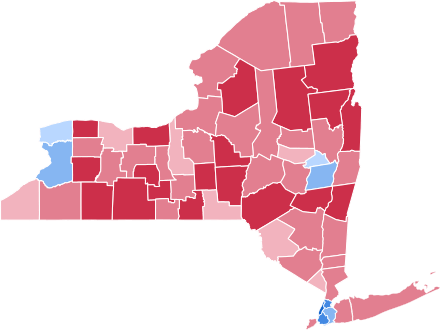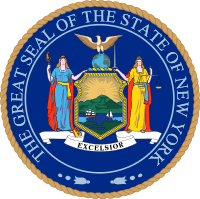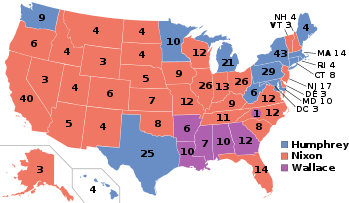United States presidential election in New York, 1968
| | |||||||||||||||||||||||||||||||||||||||
| |||||||||||||||||||||||||||||||||||||||
| |||||||||||||||||||||||||||||||||||||||
|
| |||||||||||||||||||||||||||||||||||||||
| County Results
Humphrey—70-80%
Humphrey—60-70%
Humphrey—50-60%
Humphrey—<50%
Nixon—<50%
Nixon—50-60%
Nixon—60-70% | |||||||||||||||||||||||||||||||||||||||
| |||||||||||||||||||||||||||||||||||||||

The 1968 United States presidential election in New York took place on November 5, 1968. All 50 states and the District of Columbia, were part of the 1968 United States presidential election. New York voters chose forty three electors to the Electoral College, which selected the President and Vice President.
New York was won by incumbent Democratic Vice President Hubert Humphrey, who was running against former Republican Vice President Richard Nixon. Hubert Humphrey ran with Maine Senator Edmund Muskie for Vice President, and Nixon ran with Maryland Governor Spiro Agnew. Alabama Governor George Wallace ran a strong third-party insurgent campaign as a Southern populist with his American Independent Party.
Humphrey took 49.76% of the vote to Nixon's 44.30%, a victory margin of 5.46%. Wallace, a mostly Southern-oriented candidate, came in a distant third with 5.29%.
New York weighed in for this election as 7% more Democratic than the national average.
The presidential election of 1968 was a very multi-partisan election for New York, with almost 6% of the electorate voting for Third Parties.[2] In typical form for the time, the highly populated centers of New York City, Buffalo, and Albany, voted Democratic, while the smaller counties in New York turned out for Nixon as the Republican candidate.
Humphrey won the election in New York with a strong 5 point margin. The election results in New York represent a trend in the national mentality towards progressive politics, resulting from nationwide emergence of the hippie counterculture, the race riots following the assassination of Martin Luther King Jr., numerous demonstrations in opposition to the Vietnam War, and the violent confrontation between police and protesters at the 1968 Democratic National Convention in Chicago. Humphrey was seen by many as promising to continue the reformist legacy of President Johnson,[3] and this garnered him much support by liberal voters across America.
Nationwide, the election of 1968 was very contentious across the United States. Nixon, running on a largely socially conservative agenda, was able to attain victory nationwide with less than 1% popular lead on Humphrey, while the (traditionally for the time) Democratic stronghold of the Deep South turned out en masse for their own George Wallace, who was spearheading the new American Independent Party, which was able to gain more than 5% in the State of New York, despite being so far from its base.
Results
| United States presidential election in New York, 1968 | |||||
|---|---|---|---|---|---|
| Party | Candidate | Votes | Percentage | Electoral votes | |
| Democratic | Hubert Humphrey | 3,066,848 | 45.17% | ||
| Liberal | Hubert Humphrey | 311,622 | 4.59% | ||
| Total | Hubert Humphrey | 3,378,470 | 49.76% | 43 | |
| Republican | Richard Nixon | 3,007,932 | 44.30% | 0 | |
| American Independent (a) | George Wallace | 358,864 | 5.29% | 0 | |
| Peace and Freedom | Dick Gregory | 24,517 | 0.36% | 0 | |
| Socialist Workers | Fred Halstead | 11,851 | 0.17% | 0 | |
| Socialist Labor | Henning Blomen | 8,432 | 0.12% | 0 | |
| Totals | 6,790,066 | 100.0% | 43 | ||
(a) New York law forbids the use of the word "American" in a party's name, and so the American Independent Party was named as the "Courage Party" on the ballot in New York State.
See also
- 1968 Democratic National Convention
- African-American Civil Rights Movement
- Presidency of Richard Nixon
- Watergate Scandal
- Vietnam War
References
- ↑ Although he was born in California and he served as a U.S. Senator from California, in 1968 Richard Nixon's official state of residence was New York, having moved there to practice law after his defeat in the 1962 California gubernatorial election. During his first term as president, Nixon re-established his residency in California. Consequently, most reliable reference books list Nixon's home state as New York in the 1968 election and his home state as California in the 1972 (and 1960) election.
- ↑ "Dave Leip's Atlas of U.S. Presidential Elections". Uselectionatlas.org. Retrieved 2013-07-12.
- ↑ Lewis L. Gould (2010). 1968: The Election That Changed America. Government Institutes. pp. 16–18.






